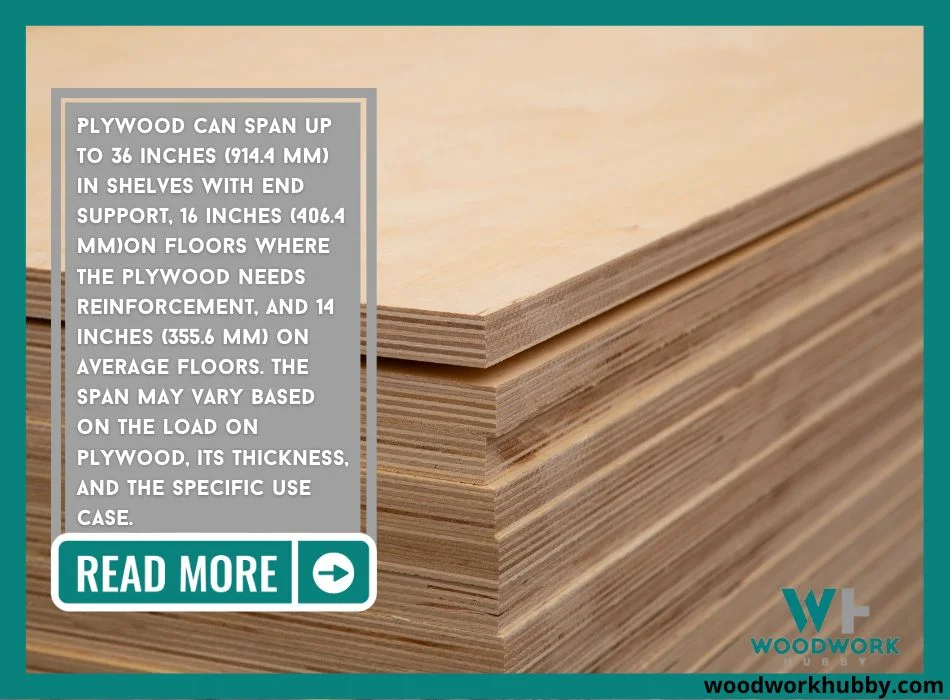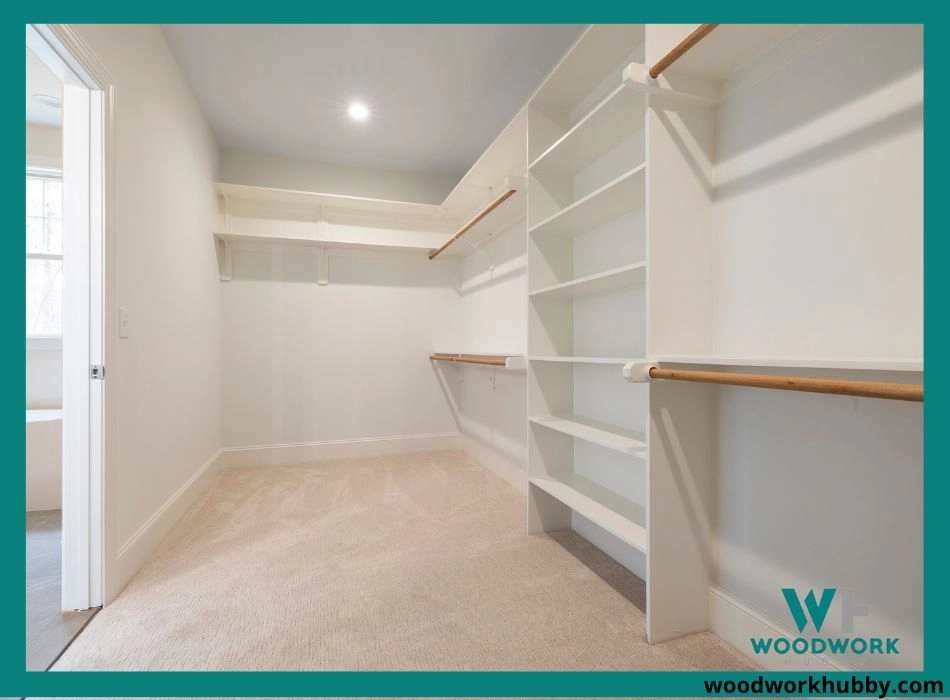Two days ago, my friend called me asking how far plywood could span. I gave him an answer thinking he was setting up a shelf. A few hours later, he called, frustrated about how it didn’t seem to balance, and the floor would not be stable.
“The floor?” I asked as I realized he was talking about plywood flooring. I decided to write an article covering plywood span in different contexts as well as for different types.
In general, 3/4 inch (19mm) plywood can span up to 36 inches (914.4 mm) in shelves with end support, 16 inches (406.4 mm)on floors where the plywood needs reinforcement and 14 inches (355.6 mm) on average floors. The span may vary based on the load on plywood, its thickness, and the specific use case.

In this article, you will learn how each factor affects span and what the span of plywood is at different depths. You will also find out the kind of weight plywood of different thicknesses can handle. Consider this your guide to plywood use in floors, roofing, and even shelves.
A video showing Plywood, Span Codes, and Fall Protection System.
Terms To Understand: Span, Depth, Load, And Use Case
How Far Can Plywood Span?
Before you find out the best span for plywood of a specific thickness or in a certain use case, you must be familiar with a few terms and how they relate to each other. Upon finding out this information, you’ll be able to glance at a few tables in this post and understand them instantly.
- Span – This refers to the length of plywood that can be extended before it needs support.
- Depth – This refers to the thickness of the plywood board.
- Load – This refers to the active weight of the plywood.
- Use Case – This refers to the specific project in which the plywood is being used.
The thickness of the plywood determines its span. But the span can vary based on the use case. For instance, ¾-inch (19.05 mm) plywood can have a 36-inch (914.4 mm) span, but only on shelves. This span doesn’t function in flooring because the active weight on the floor isn’t even close to that on a shelf.
The more intense the use case, the higher the load and the more the need for support. Span actually refers to the maximum length a material can extend without support.
Hold out your arm in front of you. Make it as straight as possible. That’s the span of your arm. Now place a dumbbell in your hand. Guess what? The arm cannot be as long. Why? Because there is more load on it.
Now you would need another person beneath your hand holding it up to keep a straight arm. That is what an end-support is for a shelf.
All in all, you must remember that span becomes relative when it comes to load difference and the ways in which plywood is used. So you should know the thickness of the plywood, the use case (flooring, roof, or shelf), and the weight it is supposed to support. Knowing these, you will be able to get the right specifications for reinforcing the plywood.
How Much Load Can 3/4 (19.05 mm) Plywood Support?
Since thickness is one of the critical factors in determining the plywood’s support capacity, you should always begin by identifying the depth of the plywood panel. This dictates not just its span but also how much load it can bear.
¾-inch (19.05 mm) plywood can support 170 lbs per square foot. Since most plywood boards are limited by the project in which they are embedded, a typical ¾-inch (19.05 mm) plywood panel carries 50 lbs.
| Plywood Length | Plywood Width | Plywood Depth | Practical Load Capacity |
|---|---|---|---|
| 1 foot | 1 foot | ¾-inches | 10 lbs |
| 36 inches | 12 inches | ¾-inches | 50 lbs |
| 4 feet | 8 feet | ¾-inches | 540 lbs |
| 5 feet | 5 feet | ¾-inches | 420 lbs |
The practical load capacity of plywood is around 10 times smaller than the theoretical capacity of plywood. The peak of plywood’s weight-bearing capacity is in flooring because the structure isn’t limited by whatever holds it up.
That’s why you will notice that plywood sheathing and floor support have higher capacity than plywood spanning between beams or being used in shelves.
I also wrote a detailed article showing how many sheets of plywood in a bundle. Please be sure to check it out before ordering your next bundle of plywood.
Plywood can sag when it is suspended between two points. It can droop even worse and under its own weight if the panel is long and has no end support. Regardless of whether you use plywood for a shelf or for your flooring, you must be mindful of its span rating alongside its weight-bearing capacity.

The weight capacity suggests that a plank of plywood can bear a specific maximum weight without getting crushed. That’s why a ¾-inch (19.05 mm) 5×5 plywood has a 5000 lbs+ weight capacity. You can place that much weight on a ¾-inch 5×5 plywood while it is on the ground and avoid destroying the plywood.
But when the same plywood is used in a shelf, the sides that hold it and the capacity they can bear limit the plywood. The most you can expect plywood to carry is a few hundred lbs, and that too when it is within its appropriate span.
What Is The Span Rating For Plywood?
The span rating for plywood is a measurement of the maximum distance between the center-to-center space along a plywood plank that can be allowed before perpendicular support is required. This depends mostly on the plywood thickness and its distance from the ground.
Given that most ½-inch (12.7 mm) plywood planks have a 24-inch (609.6 mm) flooring span, you cannot leave more than 24 inches (609.6 mm) of ½-inch-thick (12.7 mm) plywood stranded without it drooping. After every 24 inches, there must be something beneath the plywood supporting it.
In most cases, that’s ¾-inch plywood running at a right angle. It looks like a grid from the top with center-to-center spacing intersected at right angles by a parallel alignment.
You can read the plywood span rating by looking at the top number or the bottom number. The top digits show the span measurement for roof and roof-adjacent uses, and the bottom digits show the span for flooring use. In either case, there is a span, which means that plywood is reinforced every 24 or so inches.
How Do You Reinforce 3/4 Plywood?
You reinforce plywood by adding perpendicular strips under it. Ultimately, plywood is sufficiently strong and is limited by structure. By adding a support structure under it, you can improve its load-bearing capacity.
- For a desk – Add a grid of plywood strips underneath the main plank
- For a shelf – Add end supports if possible or a stiffener rail on the edge along the front.
- For roofing and flooring – Add thicker plywood beams underneath at the right span.
When there are beams underneath the plywood at the right span, it can go back to its 170 lbs-per-sqft weight-bearing capacity.
The reinforcement, then, isn’t meant to increase plywood’s weight-bearing capacity. It is just there to keep the plywood from being limited by structural weakness.
People often assume limits regarding plywood’s loadbearing capacity because they think of shelves when they see plywood. I have used plywood in flooring projects and have seen walk-over plywood-padded floors for years without issues.
A video showing when to use a 1/2″ plywood and 3/4″ plywood.
How Thick Should Plywood Be To Walk On?
Plywood should be at least ¾-inches thick to walk on because even in a flooring use case, it is lifted and hence can bend if it is thinner than ¾-inches. Thicker plywood can be too rigid and might not be ideal for flooring, either.

A ¾-inch thickness alongside a span of 18 inches would make your plywood floor pretty structurally sound under foot traffic. If the plywood is further covered by top floor material, then it can span 24 inches.
Usually, the lower the span, the safer the flooring material. But if you don’t know the optimal span for plywood, you might waste money adding more reinforcements than necessary. That’s why I always recommend understanding the maximum span of material before using it.
Length Of A Plywood Span?
Plywood can span 36 inches in shelves and 24 inches in flooring, and 32 inches in roofing. Beyond these maximum span measurements, plywood can begin to droop or bend depending on the active weight on the floor or roof.
The span rating usually assumes a certain load. But it is possible to accidentally exceed said load and damage plywood anyway. Let’s suppose you got plywood with a 16-inch recommended span. Using it in flooring, you followed the span directions and laid the floor as recommended.
If you tried to drive a Hummer over the floor, the plywood would still bend and break. That’s because the span assumes foot traffic and furniture weight. So, while it is useful to know how far plywood can span at different sizes, it is even more important to be mindful of the weight of the overall structure.
How To Find Plywood Span?
To find the plywood span, you should refer to the span rating of the specific plywood, as the span can vary from manufacturer to manufacturer and grade to grade. The first number in the span rating refers to roof and wall support.
That’s how far the plywood would span if attached to a wall or used on a roof. The second number indicates plywood span in a flooring use case.
If you do not have a specific span rating, you can go by the average span by thickness values of plywood. Though these can vary by grade, you can get decent results following the different thickness-to-span ratios covered in the table below.
| Plywood Thickness | Span |
|---|---|
| 19/32” (15.08mm) | 20″ (508mm) |
| 23/32” (18.26 mm) | 24″ (609mm) |
| 1” (25.4 mm) | 32″ (812mm) |
| 11/32” (8.73 mm) | 16″ (406mm) |
| 15/32” (11.90 mm) | 18″ (457mm) |
Remember, these are general span values that aren’t meant to replace the rating provided by the manufacturer. Even if you have plywood of the same thickness from a different brand and you see a different span rating, follow it.
Plywood Span Ratings: How Reliable Are They?
Every span rating provided by the manufacturer of certain plywood is reliable for that plywood. However, any unnatural weight or pressure on the plywood can still break or bend well-balanced plywood. That’s not the fault of the span or the reinforcement, though. All materials have their limits.
Plywood spans become unreliable when you go from brand to brand or grade to grade. Different plywood planks are made of different materials. That’s why their span can vary despite having the same thickness.
For plywood of the same type, the span can vary based on thickness. But the moment you deal with two different types of plywood, the span rating isn’t transferable.
Also, be sure to see my article explaining if cabinet-grade plywood will warp.
Does All Plywood Have The Same Span?
All plywood doesn’t have the same span. In fact, all plywood with the same thickness also doesn’t have the same span. The span of plywood can vary based on the thickness of the individual plays within the plywood board, the type of wood used, the resin used, and the grade of the plywood.
Span is a sign of structural strength. The stronger the plywood, the further it can span without the need for support. On the other hand, the weaker it is, the lower its span gets.
That’s why ¾-inch (19.05 mm) plywood can span 24 inches (609.6 mm) without any problem, while ½-inch (12.7 mm) plywood starts bending under your feet even with a 16-inch (406.4 mm) span.
To get the most accurate span, you should check the manufacturer-given span rating. And if you cannot get that, you should at least get the plywood type and thickness right and then see how far it spans.
Given that most plywood for flooring use cases is ¾-inches thick, here is a table covering the span ratings of different types of plywood.
| Plywood Type | Span Rating |
|---|---|
| Marine Plywood | 32 / 24 |
| Birch Plywood | 32 / 24 |
| B-Grade Plywood | 24 / 16 |
| C-Grade Plywood | 16 / 12 |
| CDX Plywood | 12 / 10 |
What Happens If You Make A Mistake In Span Calculation?
If you make a mistake in the span calculation, the plywood starts to bend under the weight. It can ultimately snap or crack. The objects on the plywood are in constant danger of falling. If you can get beneath the plywood, you can reinforce it after noticing it flex under your weight.
To fix a spanning issue in plywood, you should add a perpendicular board or a solid block under the plank where it seems to be bending. For most floors, it works but can require a lot of effort. It is much better to get it right the first time.
Final Thoughts
If your plywood is thick enough, you can have a 16-inch (406.4 mm) span and be pretty secure. But depending on how sturdy the plywood is, it can also have a 24-inch (609.6 mm) span which is the average for ¾-inch (19.05 mm) plywood. Still, check the manufacturer-given span rating, as it is more precise and reliable than any general rating.



